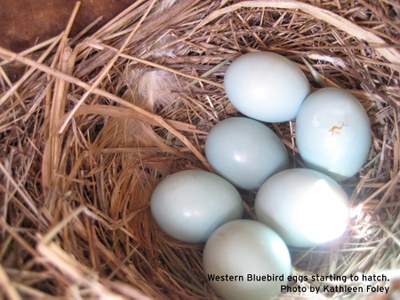
by Mia Spangenberg, Mountaineers Hike and Naturalist Leader
Prairie savannas dotted with Garry oak trees — the only native oak species in Washington, Oregon, and British Columbia — used to be common throughout the Puget trough, including the San Juan Islands. As human development and Douglas fir have encroached, this unique ecosystem has shrunk to less than five percent of its historic range in this area, and birds like the Western bluebird, that need open spaces, have disappeared along with it.
Western bluebirds, like American robins, belong to the thrush family. They are smaller than their cousins, at about 5.5 inches long, but the male can easily be distinguished with his deep blue head, wings, and tail, and rufous chest. Western bluebirds are insectivores, but when they head south for the winter, they alter their diet to take advantage of berry crops available in their wintering areas. These birds are secondary cavity-nesters, meaning they rely on woodpeckers or other species to excavate nesting cavities.
In the San Juan Islands, the Western bluebird was still relatively common in the 1920s, but they had been extirpated by the 1960s. According to Kathleen Foley, stewardship manager at the San Juan Preservation Trust, there are almost no pure grasslands left on the islands at all — sheep grazed out the native grasses when the Europeans arrived in the mid-1800s, and dead trees, important for cavity-nesters like Western bluebirds, were all but removed. Invasive species like Scotch broom have also invaded many open areas.
Western bluebirds, have, however, learned to adapt to farmland and fallow fields, and they respond well to artificial nest cavities, like nest boxes. Their adaptability to man-made nest structures has in fact helped their population to rebound around the Fort Lewis area, just south of Tacoma. On the heels of this success, the San Juan Islands Western Bluebird Reintroduction project has taken a stab at reestablishing a home base for these emblematic birds, missing from the islands for almost 50 years. “It’s an opportunity to increase biological diversity with a charismatic bird that is easy to work with, and to draw attention to the disappearing prairie-oak system,” explains Foley.
Still, this project is the first known reintroduction of a migratory songbird in the U.S. “We were gambling in the early years because we didn’t know if the birds would return or not, but they did,” says Foley.

Over a span of five years, from 2007 to 2011, Foley and the other coordinating partners of the project, the American Bird Conservancy and Ecostudies Insititute, translocated five to six breeding pairs of Western bluebirds from Fort Lewis every year. They staked out appropriate habitat for the birds, away from urban areas and their feathered competitors, European starlings and English house sparrows. Local residents became key hosts for the birds; almost all releases and nest box placements were conducted on private land. They drilled the entrance holes of the nest boxes to a specific diameter to keep out the larger starlings, and also put up extenders to prevent raccoons from reaching up to get at the nestlings. Cats are another major predator, and residents were encouraged to keep their cats indoors at least for the duration of the nesting season. Once the birds had become accustomed to their surroundings, after about two to three weeks, they were released to begin nesting in their new home.
By 2011, the population had crept up to 38 birds, even after losses to cats and nest takeovers by house sparrows. But by 2013, the population had dropped significantly to about 14 birds, apparently due to several cold, wet springs that resulted in nest mortality. Last year, the team undertook an emergency translocation of three pairs of bluebirds from the Fort Lewis prairie and from the Willamette Valley in Oregon to see if that would help stabilize the population. This year they will monitor the birds and hope for the best; further translocation efforts are subject to funding levels.
While the population is small, Foley points out that the San Juan Islands and Vancouver Island constitute the northern edge of the Western bluebird’s historic range, and so these birds probably weren’t there in very large numbers to begin with. Instead, she counts the fact that the birds are re-creating their historic flight path as one of the great successes of the project. “We have one documented case of a San Juan Island bird breeding on Vancouver Island, and a Fort Lewis bird also migrated to San Juan Island to successfully breed,” says Foley.
In years to come, Foley would like to see a healthy bluebird population stewarded by volunteers in the community and a biologically diverse and rich place for people to visit. “Oak-prairie habitat is very rare, and contains many species we can’t find elsewhere, like the Camas lily, Henderson’s shooting star, and the Chocolate lily. We want to be sure that the Western bluebird remains part of this natural heritage.”
Read more about the Western bluebird reintroduction project and find out how to get involved here.
 Mia Spangenberg
Mia Spangenberg